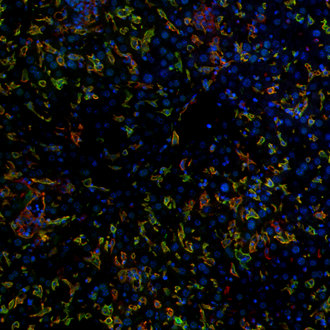
| Cat. No. HS-501 003 |
50 µg specific antibody, lyophilized. Affinity purified with the immunogen. Albumin and azide were added for stabilization. For reconstitution add 50 µl H2O to get a 1mg/ml solution in PBS. Then aliquot and store at -20°C to -80°C until use. Antibodies should be stored at +4°C when still lyophilized. Do not freeze! |
| Applications | |
| Immunogen | Synthetic peptide corresponding to residues near the carboxy terminus of mouse CLEC4F (UniProt Id: P70194) |
| Reactivity |
Reacts with: mouse (P70194). Other species not tested yet. |
| Remarks |
IHC: Antigen retrieval with citrate buffer pH 6 is required. |
| Data sheet | hs-501_003.pdf |

Immunodetection of CLEC4F-positive Kupffer cells (green) and F4/80-positive macrophages (red) in a mouse liver infected with T. gondii.
The murine CLEC4F is a hallmark of mouse Kupffer cells (KCs) and its expression distinguishes KCs and recruited macrophages (1). CLEC4F is a C-type lectin participating in the antigen presentation of glycolipid antigens, as well as in the recognition and scavenging of desialylated platelets (2). The human CLEC4F gene does not encode a functional receptor due to a mutation in the splice acceptor site of the final exon preventing the appropriate splicing and a missense mutation disrupts the sugar-binding site (3). CLEC4F colocalises with F4/80. Although F4/80 is constitutively expressed in peripheral and resident macrophages, CLEC4F is inducible in the liver and its expression appears when primitive macrophages migrate into the fetal liver. Moreover, CLEC4F and F4/80 cells in the liver increase after infection (4).